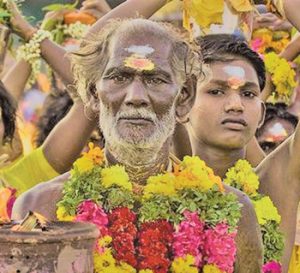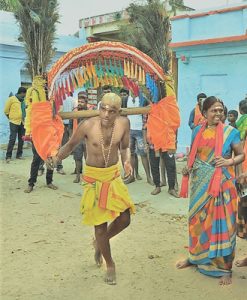Hinduism rituals bring spirituality into human life and inculcate feelings of devotion. The Vedas are a collection of hymns and rituals dating back thousands of years. Rituals are as old as life. They connect humans to the divine realm. Most of us have witnessed Hindu devotees clad in yellow, orange and red with garlands around their necks, at various Kovil festivals. As the ceremony unfolds we witness chanting and pulsating drumbeats rising into the air.
The confluence of faith and endurance
“Kavadi” dancers captivate the viewer with their movements. The calculated steps of men and women with their bodies pierced with thin metal skewers. A man with multiple hooks firmly set into his skin and being suspended on a wooden chariot adds to the mystery of these rituals of penance. I heard believers’ zealous chanting.

The Kavadi dance is a centuries-old tradition that is practised by Hindus all over the world.
What does one make of this display of endurance and tenacity of faith? Sri Lankans’ Hindu cultural and religious beliefs are manifested here. Do these people truly feel pain or has their mind transcended the human boundary and connected to a higher realm of divine attainment? Is penance necessary for spiritual transformation? Let us journey together to understand these traditions and respect the beliefs embodied within these ancient rituals.
When we attempt to understand the timeless rituals of other religions, we must first realise that every human has the right to indulge in their chosen form of worship. This is a reflection of our personal faith. It will obviously differ from worship forms within our own religions. Secondly, as refined people, we must learn to observe in a way that does not disturb those whose spiritual doctrines differ This is indeed the mark of a discernible human.
Kavadi
The first time I saw a group of Kavadi dancers was in Colombo in the 1980s, as I travelled with some Hindu friends. I was surprised to see how devotees engaged in this dance with such zeal. Basically, the Kavadi is a dance of burden, where a semi-circular piece of wood is carried on It stems from the ancient story of Idumban. We often see the wooden device decorated with peacock feathers. It is a ceremonial dance performed to invoke the blessings of Murugan, the Hindu God of War. Many opine that the Kavadi dancer is praying for the healing of a sick family member among other prayer requests.
According to ancient tradition, the deity Shiva had entrusted two hillocks to the sage Agastaya, who gave the task of moving the hills to his disciple Idumban. At one stage of his journey, Idumban could not carry the two hillocks. Subsequently, the tale mentions that Idumban had declared that people could carry a Kavadi (symbolising his own act of lifting the two hillocks) as a form of penance to obtain divine blessings.
In India, it is widely believed that Idumban stands as a sentinel over a sacred mountain in Palani, where a shrine has been built. This custom has been followed for centuries by devotees. Songs of faith are sung and the famous composer of Kavadi Chindu is said to be Annamalai Reddiar.
On a visit to Jaffna a few years ago I was privileged to witness a group of people engaged in Kavadi Attam (dance). I was heading to a venue with my host Jeyakumar when we halted the motorcycle and joined the crowd. Generally, this dancing ritual takes place somewhere in January/February in the Tamil calendar months coinciding with Thaipusai. However, the dance is now performed as part of the Kovil festivals.
Vegetarian diet

Kavadi devotees dance through the streets in a display of faith and endurance.
All those engaging in the Kavadi ritual must rid themselves of habits that make them impure. Observing a vegetarian diet is necessary. Some opine that as per Indian tradition, one must remain on a vegetarian diet for 48 days. Some devotees follow the rule of shaving their heads (males) and bathing in cold water. Over the past few decades, some have begun carrying a simple pot of milk on their heads, a symbolic gesture of burden. This practice is common among Hindu women.
Another segment of the Kavadi ritual is kudirai attam (kudirai is the Tamil word for horse). This old form of folk dance is performed by young women with a hardboard design of a horse’s head-worn around the waist. Legend says the horse dance is done to please the guardian Ayyanar.
Piercing rituals
Synonymous with the Kavadi is the Vel Kavadi ritual. Piercing the body is a practice in various religions. The act of piercing and the pain endured denote sacrifice. The ancient Aztecs and Mayans pierced their tongues. Flagellation is also part of religious rituals but I have not seen it in Sri Lanka. It is where a person whips their body causing the skin to bruise and bleed. We wonder how these devotees endure their pain, as the ritual lasts for many hours. It is definitely a form of heavy penance involving metal skewers and tridents. Hindu literature has a theory that Goddess Parvathi gave a spear (vel) to Murugan by which he killed the demon Soorapadman. This gives us an idea about the symbolic metal skewer that penetrates people’s tongues and cheeks.
It is basically a symbolic triumph of good over evil. In the original Indian rite, the Vel Kavadi requires 108 hooks that must be attached to the skin of the devotee. I have never seen these many hooks used in Sri Lanka.
Some Hindus believe at the height of pain, the devotee falls into a trance. When in a trance, devotees can often have needles and hooks pierced through their flesh without bleeding. They can even dance in nailed shoes without pain.
Tested in flames
The final enigmatic ritual that is performed occasionally during Kavadi dancing is fire walking. I have seen this in many parts of Sri Lanka, especially in Jaffna. This is literally a walk of faith on burning embers. Though mainly undertaken by males, I have seen a few women doing this ritual known as Theemithi, an offering to Draupathi Amman. During more prestigious festivals, the men engage in Angaipirathachanam- the gruelling task of rolling within the Kovil garden.
It is interesting that in the famous Hindu epic, the Ramayana, the heroine Sita, wife of Rama who is also regarded as an incarnation of Lakshmi, appealed to the fire god, Agni, to bear witness to her wifely fidelity by protecting her as she threw herself into the fire. She emerged unscathed, protected by her purity.
Rituals will remain for decades to come. It is a display of faith that is devoted to the work of God. Motivation for such ritualised actions is ascribed to considerations of purity and auspiciousness. Devotion (bhakti) effectively reconciles the seemingly disparate aims of obtaining aid in solving problems and locating one’s soul in relation to divinity. Reverence is rendered and grace pours down. As a result, it enriches the Hindu devotee’s quest for self-realisation and spiritual awakening. This is a manifestation of humanity.
Dishan Joseph




